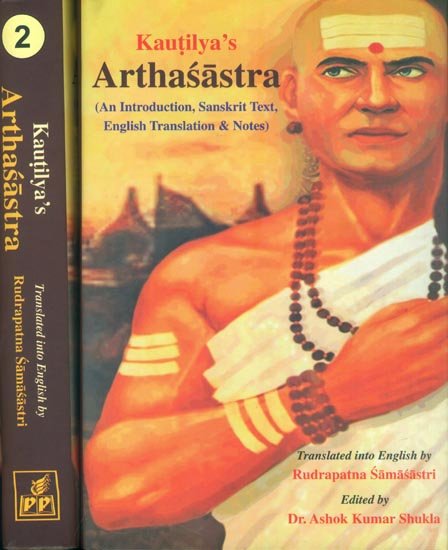Kautilya Arthashastra
by R. Shamasastry | 1956 | 174,809 words | ISBN-13: 9788171106417
The English translation of Arthashastra, which ascribes itself to the famous Brahman Kautilya (also named Vishnugupta and Chanakya) and dates from the period 321-296 B.C. The topics of the text include internal and foreign affairs, civil, military, commercial, fiscal, judicial, tables of weights, measures of length and divisions of time. Original ...
Chapter 4 - Buildings within the Fort
[Sanskrit text for this chapter is available]
Demarcation of the ground inside the fort shall be made first by opening three royal roads from west to east and three from south to north.
The fort shall contain twelve gates, provided with both a land and water way and a secret passage.
Chariot roads, royal roads, and roads leading to droṇamukha, sthāniya, country parts, and pasture grounds shall each be four daṇḍas (24 feet) in width.
Road leading to sayonīya (?), military stations (vyūha), burial or cremation grounds, and to villages shall be eight daṇḍas in width.
Roads to gardens, groves, and forests shall be four daṇḍas.
Roads leading to elephant forests shall be two daṇḍas.
Roads for chariots shall be five aratnis (7½ feet). Roads for cattle shall measure four aratnis; and roads for minor quadrupeds and men two aratnis.
Royal buildings shall be constructed on strong grounds.
In the midst of the houses of the people of all the four castes and to the north from the centre of the ground inside the fort, the king’s palace, facing either the north or the east shall, as described elsewhere (Chapter XX, Book I), be constructed, occupying one-ninth of the whole site inside the fort.
Royal teachers, priests, sacrificial place, water reservoir and ministers shall occupy sites east by north to the palace.
Royal kitchen, elephant stables, and the store-house shall be situated on sites east by south.
On the eastern side, merchants trading in scents, garlands, grains, and liquids, together with expert artisans and the people of Kṣatriya caste shall have their habitations.
The treasury, the accountants’ office, and various manufactories (karmaniṣadyāsca) shall be situated on sites south by east.
The store-house of forest produce and the arsenal shall be constructed on sites south by west.
To the south, the superintendents of the city, of commerce, of manufactories, and of the army as well as those who trade in cooked rice, liquor, and flesh, besides prostitutes, musicians, and the people of Vaiśya caste shall live.
To the west by south, stables of asses, camels, and working house.
To the west by north, stables of conveyances and chariots.
To the west, artisans manufacturing worsted threads, cotton threads, bamboo-mats, skins, armours, weapons, and gloves, as well as the people of śūdra caste, shall have their dwellings.
To the north by west, shops and hospitals.
To the north by east, the treasury and the stables of cows and horses.
To the north, the royal tutelary deity of the city, ironsmiths, artisans working on precious stones, as well as Brāhmans shall reside.
In the several corners, guilds and corporations of workmen shall reside.
In the centre of the city, the apartments of gods, such as Aparājita, Apratihata, Jayanta,Vaijayanta, Śiva,Vaiśravaṇa, Āśvina (divine physicians), and the abode of Goddess Madirā (Śrī Madirāgṛha) shall be situated.[1]
In the corners, the guardian deities of the ground shall be appropriately set up.
Likewise the principal gates, such as Brāhma, Aindra, Yāmya, and Saināpatya shall be constructed; and at a distance of 100 bows (dhanus = 96 aṅgulas) from the ditch (on the counterscarp side), places of worship and pilgrimage, groves and buildings shall be constructed.
Guardian deities of all quarters shall also be set up in quarters appropriate to them.
Either to the north or the east, burial or cremation grounds shall be situated; but that of the people of the highest caste shall be to the south (of the city).
Violation of this rule shall be punished with the first amercement;
Heretics and Caṇḍālas shall live beyond the burial grounds.
Families of workmen may in any other way be provided with sites befitting their occupation and field work. Besides working in flower gardens, fruit gardens, vegetable gardens, and paddy fields allotted to them, they (families) shall collect grains and merchandise in abundance as authorised.
There shall be a water well for every ten houses.
Oils, grains, sugar, salt, medicinal articles, dry or fresh vegetables, meadow grass, dried flesh, haystock, firewood, metals, skins, charcoal, tendons (snāyu), poison, horns, bamboo, fibrous garments, strong timber, weapons, armour, and stones shall also be stored (in the fort) in such quantities as can be enjoyed for years together without feeling any want. Of such collection, old things shall be replaced by new ones when received.
Elephants, cavalry, chariots, and infantry shall each be officered with many chiefs, inasmuch as chiefs, when many, are under the fear of betrayal from each other and scarcely liable to the insinuations and intrigues of an enemy.
The same rule shall hold good with the appointment of boundary guards, and repairers of fortifications.
Never shall Bāhirikas who are dangerous to the well-being of cities and countries be kept in forts. They may either be thrown in country parts or compelled to pay taxes.[2]
[Thus ends Chapter IV, “Buildings within the Fort,” in Book II, “The Duties of Government Superintendents” of the Arthaśāstra of Kauṭilya. End of twenty-fifth chapter from the beginning.]
Footnotes and references:
[1]:
The worship of the Aśvins and Vaiśravaṇa seems to have been prevalent at the time of this work.
[2]:
In śloka-metre.
